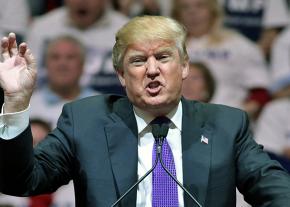Yes, we are all out to get him
reviews a book about how conspiracy-minded thinking shapes political discussion, and why, in an article for his column at Inside Higher Ed.
AMERICAN POLITICS in the age of Donald Trump may yet make armchair psychopathologists of us all. The stream-of-consciousness quality of the candidate's speeches now becomes a factor in governance. In the wee hours, while most of us sleep, the president-elect tweets. Stephen Dedalus' description of history as "a nightmare from which I am trying to awake" feels less literary by the hour.
And so the public is compelled to play analyst: armed with diagnostic checklists and extensive Wikipedian training, we try to categorize his personality (as narcissistic, borderline, histrionic, etc.) in hopes that an adequate label might provide some hint of what to expect over the next four years. It won't, of course, although the odds that a State of the Union speech will address the president's penis size have increased considerably.
On a more substantial matter, it's obvious that Trump's affinity for the conspiratorial mind-set goes beyond a mutual appreciation of talk-show host Alex Jones. It forms the bedrock of Trump's very existence as a political figure. His aspiration to something greater than mere celebritydom began in earnest only when Trump made himself a major player in the pseudo-controversy over President Obama's birth certificate. (That racist melodrama assumed, even if it did not always emphasize, the existence of shadowy forces conspiring to put a Kenyan Muslim into office for their own un-American reasons.)

The penchant of Trump and some prominent figures in his entourage to resort to conspiratorial tropes seems like yet more evidence for the perennial value of Richard Hofstadter's "The Paranoid Style in American Politics" (1964). And while I find Michael Paul Rogin's critique of Hofstadter persuasive, there is no denying the essay's almost irresistible quotability. Some passages sound as if the historian were making a summary of the themes appealing to the president-elect's base:
America has been largely taken away from them and their kind, though they are determined to try to repossess it and to prevent the final destructive act of subversion. The old American virtues have already been eaten away by cosmopolitans and intellectuals; the old competitive capitalism has been gradually undermined by socialistic and communistic schemers; the old national security and independence have been destroyed by treasonous plots, having as their most powerful agents not merely outsiders and foreigners, but major statesmen who are at the very centers of American power.
Add complaints about political correctness for seasoning, and the reader would have no reason to think this passage is not from a report on the 2016 election.
And that is, in a way, Hofstadter's point. Hofstadter identifies the paranoid style as a recurrent if not permanent strain in American political thought and rhetoric--but also as weaker, and less effective, over the long run, than its durability might imply. It appeals to established but aggrieved groups imagining themselves to be "the real America" under threat from change. Then the immigrants and upstarts become established, new demagogues emerge to exploit their discontent, and the whole thing starts again.
ROB BROTHERTON'S book Suspicious Minds: Why We Believe Conspiracy Theories (Bloomsbury Sigma), originally published in late 2015, appeared in paperback as the Inauguration Day bleachers went up near the White House. While not a commentary on the Trump ascendancy, its timing may skew the reader's attention in that direction even so.
The author, a psychologist and science writer, is more concerned than Hofstadter with the particular cognitive processes involved in the conspiratorial mentality. Rather than pointing to a paranoid mood that ebbs and flows with political currents, Brotherton treats conspiracy theories as part of a continuum of patterns of thought and behavior that are extremely common and not, for the most part, paranoid.
Much of it comes down to pattern recognition (the brain's incessant but not always reliable drive to find order) combined with a tendency to overestimate the validity or completeness of the available information. Brotherton writes, "When we're uninformed--and we're all ignorant about a lot of things--our brain indiscriminately uses whatever is at hand to plaster over the intellectual blind spot." The author adduces a number of lab experiments showing this, including research that suggests cognitive strain tends to heighten the capacity to imagine structure where none exists.
"By painting conspiracism as some bizarre psychological tic that blights the minds of a handful of paranoid kooks," he writes, "we smugly absolve ourselves of the faulty thinking we see so readily in others. But we're doing the same thing as conspiracists who blame all of society's ills on some small shadowy cabal. And we're wrong. Conspiracy thinking is ubiquitous, because it's a product, in part, of how all of our minds are working all the time."
This is persuasive, up to a point. But somewhere far beyond that point are whole milieus of people whose pattern-recognition software got stuck in the conspiratorial program and can't be reset. There's David Icke, for one, an internationally famous author who believes that most political, social and cultural changes of recent decades are the work of shape-shifting inter-dimensional reptile people. (Icke makes Alex Jones sound like Walter Cronkite.)
Between Hofstadter's cyclical rise and fall of paranoid politics and Brotherton's rather genial vision as everyone being conspiracy-minded at one time or another, it's almost possible to imagine the next few years as something other than cataclysmic. But I'm not entirely persuaded. Suppose this is just the beginning. After all, we still have no idea where the incoming administration stands on shape-shifting inter-dimensional reptile people. The president-elect hasn't even uttered the words "shape-shifting inter-dimensional reptile people." What is he trying to hide?
First published at Inside Higher Ed.


